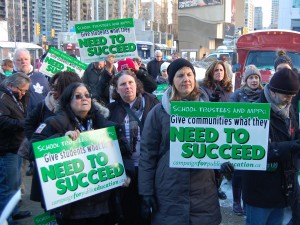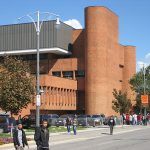community rallies to save schools
 In one rural Ontario community, an ice cream company has offered to scoop up a school to stop it from being shut down.
In one rural Ontario community, an ice cream company has offered to scoop up a school to stop it from being shut down.
Worried about the impact of the loss of the only elementary in Markdale, Chapman’s Ice Cream has a sweet deal: it will spend about $1 million to buy the building, and lease it back to the local board.
“Simply put, for the first time in literally decades, we have people wanting to invest in this area, this community and this town,” said vice-president Ashley Chapman, who himself attended Beavercrest Community School.
Chapman’s has started the first phase of a major expansion and expects to employ about 1,000 in total in five years’ time, he said. As well, “there are several proposals for subdivisions,” and plans are in place to break ground on others, “and when we are finally at the point where the town is going to explode” and be attractive to new employees and their families, its only school may close.
“Developers are going to walk away,” he added.
Beavercrest is one of an estimated 600 schools under threat across the province, and parents protested at Queen’s Park on Monday, saying rural areas are being particularly hard hit. They are asking the government for a moratorium until changes are made to a process they argue doesn’t include enough true consultation.
Shuttering a school in smaller communities often forces long commutes on kids — an estimated four-plus hours a day on a bus for Sudbury students if plans there go ahead — and doesn’t allow them to take part in extracurricular activities or get after-school jobs, said Susan MacKenzie of the Ontario Alliance Against School Closures.
Education Minister Mitzie Hunter, who along with Premier Kathleen Wynne was grilled on the issue during Monday’s question period, told reporters afterwards that the revamped closing process “ensures parent voices are heard” but that decisions are ultimately up to local boards, after consulting with the community.
“We want to make sure when we make those investments that they are being invested in student learning, student programming and student outcomes. We don’t want those very valuable education dollars for education to be funding inefficient use of space or empty classrooms. We want those funds to be used in the classroom where students are learning.”
But NDP education critic Lisa Gretzky said funds from the “geographic circumstances grant” have been cut by $10 million over the past two years, and other sources of funding are being phased out.
“To people living throughout the province, community schools are more than … just bricks and mortar,” she said. “They are often the centrepieces of both urban and rural communities.”
Chapman said he’s not sure if his offer is feasible given the rules, but is meeting with the school board on Tuesday. His plan would see the company buy the property, then lease it to the board, and the ice cream company would further invest in repairs and upgrades to modernize the building.
The local government, as well as Chapman, has also proposed giving the board around $50,000, the annual funding shortfall to keep the school open.
During question period, Wynne, a former school board trustee, said: “I know that decisions around school closures and school consolidations are some of the most difficult that school boards have to make. They require consultation with the community, including parents.”
In the 2015-16 school year, the government spent $3.7 billion on funding for rural schools, she said.
Progressive Conservative MPP Vic Fedeli told the Legislature that rural schools often have just 80 students, and “when you put these schools under a review, they can never match up with the made-in-south rules and regulations.
“Our northern schools are small because of the very nature of where they’re located. Many towns of 4,000 or 5,000 have 100 kilometres between them and the nearest community. These schools will simply not fit into the government’s mould.”
By Mon., Nov. 21, 2016



